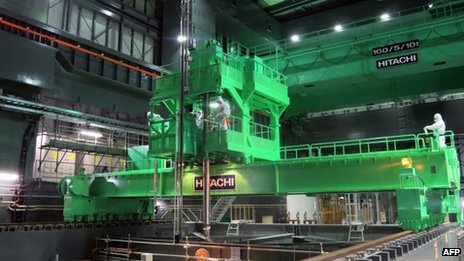
Japan's Fukushima Nuclear Plant Begins Risky Fuel Rod Removal
Workers at Japan's stricken Fukushima nuclear plant have begun removing fuel rods from a storage pond at the Unit 4 reactor building.
The delicate operation is seen as a necessary step in stabilising the site.
It will take about two days to remove the first 22 fuel rod assemblies, plant operator Tepco says.
Overall, more than 1,500 assemblies must be removed in what correspondents describe as a risky and dangerous operation set to take a year.
Experts say hydrogen explosions after the earthquake and tsunami in March 2011 have made the current storage facility vulnerable to further tremors.
The fuel rod assemblies are four-metre long tubes containing pellets of uranium fuel, and the fear is that some may have been damaged during the disaster.
Continue reading the main story
(SCROLL DOWN)
*
*
*
*
*
*
*
Removing fuel rods

- The fuel rods - 4m-long tubes containing pellets of uranium fuel - are in a precarious state in the Unit Four storage pool
- The rod assemblies will be lifted out in batches of 22 in casks filled with water, using a crane - each batch will take 7-10 days
- Two critical issues are whether the rods were damaged during the disaster and so are likely to leak, and whether the casks remain watertight so the rods have no contact with air
- The fuel rods will be deposited into a new "common" pool with a cooling system
When the tsunami struck, water knocked out cooling systems to three of Fukushima's reactors, which went into a state of partial meltdown.
Unit 4 was undergoing maintenance, so all of its fuel rods were being stored. But a build-up of hydrogen triggered an explosion in Unit 4, damaging its structure.
'Important process'
The removal process, which has been preceded by months of repair work and planning, began on Monday afternoon.
"At 15:18 [06:18 GMT], we started to pull up the first fuel assembly with a crane," a spokesman for Tepco (Tokyo Electric Power Company) said.
A recently installed crane is being lowered into the pool and hooked on to the assemblies to place them inside a cask.
http://www.bbc.co.uk/news/world-asia-24958048
